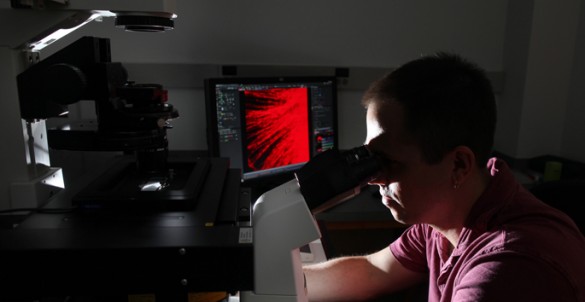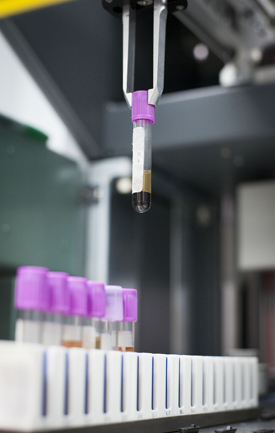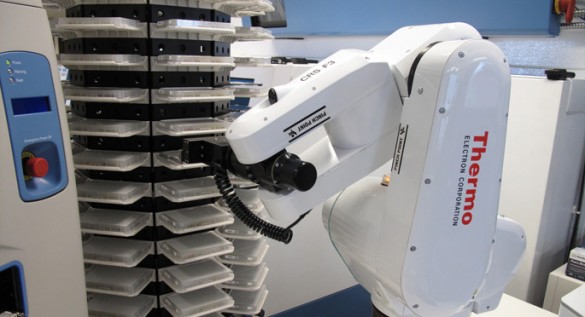
by Stephen Doster and Bill Snyder
Progress against America’s most intractable health challenges, among them heart disease, cancer and diabetes, requires the best minds, the latest tools and the easy collaboration demanded by 21st century science.
At Vanderbilt University Medical Center, those ingredients for success are found in “the cores,” 100 research facilities, centers and shared resources that are helping investigators speed up the pace of discovery.
Roger Cone, Ph.D., is one of the cores’ strongest advocates.
Cone and colleagues Masoud Ghamari-Langroudi, M.D., Ph.D., and Jerod Denton, Ph.D., recently discovered a new cell signaling pathway, thanks to an imaging technique developed by Robert Matthews, Ph.D., in the Cell Imaging Shared Resource, and tool compounds discovered by Denton with the help of the High Throughput Screening Facility.
The signaling pathway, described in the current issue of the journal Nature, appears to function to keep neurons and other cell types hyperpolarized, and thus may provide new drug discovery approaches for conditions as diverse as obesity and pre-term labor, the researchers concluded.
“We couldn’t have done it without the technical expertise of the cores,” said Cone, the Joe C. Davis Professor of Biomedical Science and chair of the Department of Molecular Physiology and Biophysics.
The cores allow “our investigators to write grants and test hypotheses that other researchers at other institutions can’t do easily,” he added. “You have to be able to bring in multiple techniques and analyze big data, and our cores allow our investigators to do that.”
Since the late 1990s, Vanderbilt has invested more than $100 million in creating and maintaining the cores.
This reflects the highly collaborative, cross-disciplinary and trans-institutional scientific culture here, said Sam Wells, Ph.D., who directs the Cell Imaging Shared Resource.

“We’re spread out in five different buildings and about 11 lab sites with approximately $7 million in advanced microscope assets, including new equipment that will let us do imaging in live deep brain tissue.
“We obtained most of our equipment through 14 years of successful NIH Shared Instrument Grant (S10) initiatives,” said Wells, research professor of Molecular Physiology and Biophysics.
“The amount of research that requires high-end imaging and the use of expensive equipment would be seriously diminished if we weren’t here with the service and expertise,” Wells added. “It would be economically unsustainable if it wasn’t in a shared environment.”
The cores aren’t limited to Vanderbilt scientists.
“We’ve had close to 150 investigators from 16 different countries come here to learn our techniques,” said David Wasserman, Ph.D., director of the Mouse Metabolic Phenotyping Center, which provides novel techniques for studying mouse models of diabetes. “Our lab manual has been downloaded tens of thousands of times.”
One of the “keys to survival” of the center, established in 2000, “is technical development in response to the emerging needs of investigators,” said Wasserman, the Annie Mary Lyle Professor and professor of Molecular Physiology and Biophysics.
So is information.
“Our cores are most effectively utilized when everyone can access up-to-date information,” said Mark Magnuson, M.D., senior scientific co-director of the Vanderbilt Transgenic Mouse/Embryonic Stem Cell Shared Resource and director of the Vanderbilt Center for Stem Cell Biology.
“Over the past half dozen years Vanderbilt, through collaboration between the Office of Research and the Center for Stem Cell Biology, built a Web-based scientific information management system called Labnodes to facilitate the timely exchange of information between scientists and cores,” said Magnuson.
This emphasis on information and new technology attracts others from around the country.
Last fall, about 90 lab managers from the South and Midwest toured the Vanderbilt cores. “I was very impressed with the leading-edge technologies the Vanderbilt cores provide,” said Kevin Knudtson, Ph.D., of the University of Iowa, president of the Midwest Association of Core Directors.
“The staff members displayed an exceptional knowledge of the technologies they demonstrated and a real passion for what they were doing,” Knudtson said. “I also was struck by how well the cores communicate with each other to explore new technologies that could not be achieved through one core alone.”
Wasserman agrees. He said his “extraordinarily talented” colleagues in the Mouse Metabolic Phenotyping Center “are not only skilled, they are patient, taking the time to educate the scientists that use the resource.”
“What makes the core run so effectively is the quality of the people who perform the challenging core services,” he adds.
Research cores highlight diversity of science
The research cores, facilities and shared resources at Vanderbilt University Medical Center are as broad and diverse as the science behind them. Here are three examples:
High Throughput Screening (HTS) Facility
A key component of Vanderbilt’s drug discovery effort, the HTS facility maintains libraries of hundreds of thousands of small molecules and automated instrumentation. Investigators screen molecules for their effect on a defined biological phenomenon.
This screening process helps identify “hits” that can be further studied and optimized, and which may lead to development of a potential therapeutic or tool compound.

Terunaga Nakagawa, M.D., Ph.D., associate professor of Molecular Physiology and Biophysics, studies the function of the AMPA glutamate receptor, including the auxiliary proteins that modulate its activity. This receptor plays an important role in synaptic transmission and brain plasticity, and has been linked to serious brain disorders.
With the help of scientists with the HTS facility, Nakagawa developed a cell-based assay to determine if a compound, when added to the experiment, would modify the signal generated upon receptor activation or even have an effect on its own.
Following the collection of a set of pilot screening data, he obtained funding through an exploratory/developmental “R21” research grant from the National Institutes of Health (NIH).
The grant will enable him and his colleagues to screen 100,000 compounds for those with the desired activity and properties. The end goal is development of a potential new drug.
Researchers can use the Vanderbilt facility for about a third of the cost of commercial HTS centers. “Based on what the investigator wants to do, we can help them do it faster, more reliably, or more economically, or identify funding for future work,” said the facility’s director, Paige Vinson, Ph.D.
“We do this through a combination of extensive resources, including compound libraries, high-end instrumentation, and dedicated, knowledgeable staff,” Vinson said. “We also ensure that we stay on the cutting edge by introducing new screening services such as siRNA and high content (imaging) capabilities.”
Mass Spectrometry Research Center (MSRC)
MSRC director Richard Caprioli, Ph.D., the Stanford Moore Professor of Biochemistry, is a national leader in the field of mass spectrometry.
He and his colleagues pioneered development of imaging mass spectrometry using matrix-assisted laser desorption/ionization (MALDI IMS) to visualize proteins, lipids and other molecules in cells and tissues. Essentially a “molecular microscope,” the technology helps reveal the function of these molecules and how function is changed by diseases like cancer.
Cost to use the core facilities in the MSRC is about a quarter of the fee charged by commercial vendors. “We only charge for data acquisition time and requested data analysis,” Caprioli explained. Computers are available at no charge for customer data analysis.
“You can stay all night,” he quipped. “Bring a cot if you want.”
Vanderbilt Antibody and Protein Resource (VAPR)
“We spend a lot of time pushing forward,” said resource director Robert Carnahan, Ph.D., assistant professor of Cancer Biology
“The way we make antibodies today is not the way we made them three or four years ago,” he said. “We’re always advancing and changing the technology, and we can do that more frequently and more rapidly than a large company would.
“We also are on the lookout for ways to add new services or utilize the expertise we have in new ways,” Carnahan added.
“This has allowed us to add areas such as recombinant protein production in several systems, protein interaction analyses, cell line development, and now selling at significant discounts many of the research tools we have made through the Molecular Cell Biology Resource Core.”
One satisfied customer is Lawrence Thompson, Ph.D., who worked for an outside company. He said the project timeline put together by Carnahan and his colleagues was aggressive but cost-effective.
“We got the entire project turned over in about three to four months after the first mouse was immunized,” Thompson said. “They generated high-quality clones of an antibody that showed high affinity for our antigen of interest. I was able to capture that antigen directly from human sera.
“This was a tall task, but it happened,” he said.












